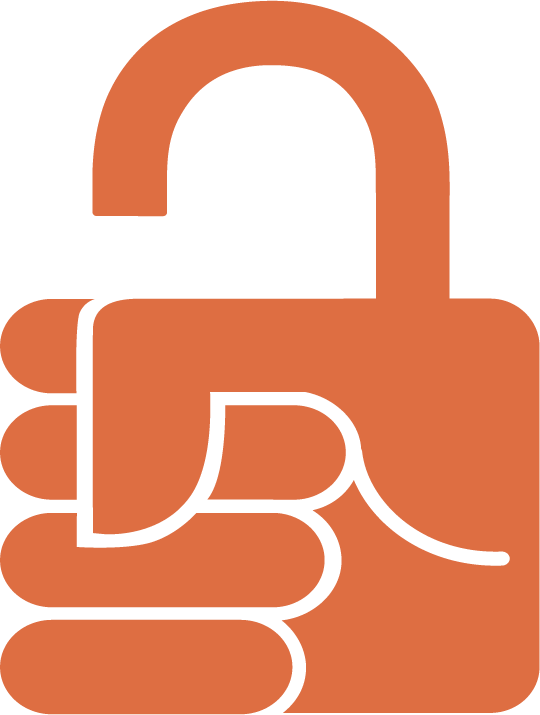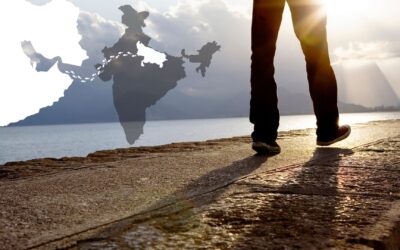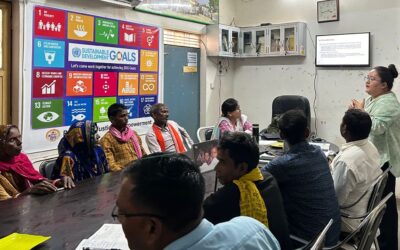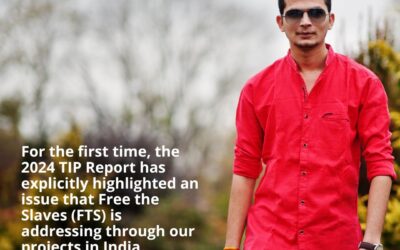Sarah Symons, founder of MadebySurvivors/The Emancipation Project (TEN) recently returned from a trip to Uttar Pradesh, India where she met with Free the Slaves partner MSEMVS (Human Resource and Women’s Empowerment)—and saw, first hand, how whole villages are breaking free of slavery. She wrote this essay, upon her return:
August 15-16, 2010, Varanasi, Uttar Pradesh, Northern India
“Without challenge, there is no life”
Today we visited five villages in Uttar Pradesh, led by Bhanuja Sharan, the Director of our incredibly impressive partner agency MSEMVS. Many of the men, women and children in these villages have been rescued by MSEMVS from bonded labor slavery in agriculture, brick kilns, stone quarries and carpet looms. Much of this work is supported by Free the Slaves, with whom we are also proud to partner, with additional support from US State Department.
Some of the villages we are seeing today were rescued last year, others as long as seven years ago, and the difference is dramatic! In the first village, Bhanuja explains that the process of rehabilitation has only been underway for 18 months. Prior to that, the women and children we meet were working as slaves in agriculture and brick kilns. The families here are all of the Dalit (untouchable) caste and have been enslaved to powerful people—landowners, slaveholders, higher caste members—for the past three generations to pay off small debts incurred by their parents or even grandparents.
Standing in the village, meeting the lovely women in the self-help group, and listening to Bhanuja explain their situation, I suddenly became quite overwhelmed with emotion and tears began to well up in my eyes. This was really not appropriate—as nobody wants to be an object of pity, and anyway the predominant mood here is one of hope. I struggled to get myself under control. I come into contact with many tragic situations in my work, so I’ve trained myself to repress my sadness until I can process it in private. but for some reason, the courage and steadfastness of this particular group of survivors broke through my practiced composure.
Thankfully, the sun was bright, so I whipped on a pair of sunglasses to continue the visit. 20 younger children, aged about 4-7 and 15 older ones were studying in simple thatched structures. These children were in slavery just a year or two ago, so they have some catching up to do before they can join a formal school. Also, the philosophy of MSEMVS is that the Indian government should fulfill their legal obligation to provide a school for these children—there is supposed to be a school every 2 kilometers for a population of this size. However, because of the pervasive cultural prejudice against Dalits, there are rarely schools in their area willing to accept them. While pressuring the district government to construct a permanent school, MSEMVS builds a temporary school and convinces parents in slavery to send their children to the school. This is the first step in the liberation of the entire community.
Because the project here is so new, many of the children showed signs of malnutrition (red, fuzzy hair is one of the signs, along with distended bellies) but their joy at having the opportunity to learn was unmistakable.
Back in the village square, we sat on the ground in a circle and swapped songs with the women’s income generation group. Theirs was a haunting melody—a guttural chant—which was sung by one group of three, then echoed by another, back and forth. We busted out an energetic but raspy version of ‘You are My Sunshine’. I used to sing professionally, but my voice is ragged right now from dust and minimal sleep and so much talking. There is so much planning and processing we need to do here in India—trying to figure out how to best use our organization’s resources to help survivors such as these. We spend a lot of time analyzing products, figuring out to improve them, adapt them to Western fashion trends, how and where we can buy raw materials, who is doing what, when and how.
The gift of this day, however, is to be in the present moment. It is hot and humid, but the countryside is green, fresh and beautiful—a welcome respite from a week in Calcutta, a city of 20 million. The women’s bright saris make a stunning contrast against the background of mud and brick houses, brown earth and rice paddies is stunning. Although we can only communicate through a translator, it is great fun to sit with the women, look into one other’s eyes, share a smile or a conversation translated by Bhanuja, listen to their strategizing and know that we are working for the same cause.
“You are women too, so you will understand,” says one woman. “We want the best for our children—to go to school rather than to work. And for ourselves, only the chance to choose our work, and to be paid for it, to care for our families and to help others. So I hope you will support us.”
“We do understand, and we will” I promise. Who could say no?! Thanks in advance to our donors and customers for making it possible to keep this promise.
These who have now been rescued are now advocating and working for the freedom and uplifting of others in the surrounding communities. Their strength and positive attitude is truly humbling. Paul described it most succinctly in his text message later that night: “Hot and humid, flies on face, no food or bathrooms, five villages freed from slavery, best day ever.”
In another village, the women told us that after they refused to work as slaves, the powerful people destroyed their road to the outside world. For two years, they fought to get a new one, travelling for five hours by tractor and bicycle to make their case with district authorities. Finally, the village prevailed and they now have a fine new stretch of road connecting them to the rest of the world.
I asked them what challenges they still face.
“Without challenge, there is no life,” the group leader replied. She went on to explain that there will always be troubles and challenges as long as you are alive in this world. But as long as they have their freedom, they are ready to take them all on.
We bought several thousand handmade glass beads from two of the villages’ women’s self-help groups. These beads will be made into earrings and necklaces by survivors of brothel slavery at our jewelry center in Calcutta. We watched some survivor-artisans creating the beads by turning glass rods on a tiny spit through a gas flame—a process called lampworking. It is a wonderful feeling to see up close how these familiar products (the glass bead earrings are a MadeBySurvivors classic) are helping to transform the lives of these former slaves and to make their once destitute and marginalized village into a place of hope and inspiration.
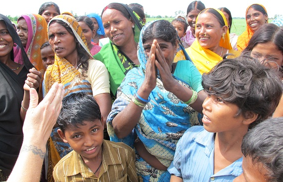 Day two: Freedom School
Day two: Freedom School
On our second day with MSEMVS, we travelled to Chandauli district, about 3 hours from Varanasi, where we have been fortunate enough to sponsor a school in the village of Firojpur, at the invitation of Free the Slaves’ Ginny Baumann. Free the Slaves is sponsoring the other efforts to help the community to permanent freedom, including the women’s self help group, income generation projects and rights-based community outreach.Many instances of bonded labor had been reported from the village, so MSEMVS began an intervention in 2009, and the school was built last summer.
I was moved again to tears when I saw this simple but beautiful thatched school, and the 52 children aged 4-12, who are receiving a top quality education there. I felt honored to see our organization’s name, alongside Free the Slaves on a brightly colored sign.
Just one year ago, many of these little ones were working alongside their parents in stone quarries or in agriculture to pay off ‘debts’. These villagers had been enslaved for three generations, and so the men and women I see—people of my own generation—have never known freedom until now. This is staggering to contemplate.
The children have either never been to school, or had been forced to leave school to work. Despite their lack of educational background, the kids are on track educationally—the older ones have advanced in just one year from kindergarten to class 3 and 4. My heart sang as I watched them reading ably in Hindi and English. Literacy will help to ensure that they will know their rights, can read a contract, and thus cannot be tricked into slavery.
Along with the three R’s, these children, and their mothers in the women’s self help group, are receiving intensive education about their human rights. As Dalits, they have been denied access to even the most basic and limited resources, some of which are available locally, but controlled by the higher caste people – education, supplemental feeding programs for babies and children, roads, clean water, health care and the right to earn wages for their work.
It is hard to convey the deprivation and despair of the village prior to MSEMVS’ intervention—we saw the ‘before’ picture in some of the villages we passed through on the way here. Pervasive malnutrition, child labor, desperate poverty, hopelessness, isolation and fear. One of the greatest gifts of the school and empowerment program is that it has united the neighbors and given them a strong sense of community. Before, according to Bhanuja, every family just stayed in their own hut—a shame and fear-based society which helped to ensure that no one would fight back against the powerful people. The untouchables had little contact with each other, and their only contact with the higher caste people was a relationship of slavery and abuse. Dalits traditionally live South of the main villages, Bhanuja explained. Their powerlessness was advantageous to people of higher caste. Though still poor, the higher caste villagers could feel better about themselves by degrading these people, and stealing what little resources were designated for them.

Women’s income generation project
Things are different now
We sat with the women in the self help group, and asked about their dreams and struggles. Like some of the freed villages we visited yesterday, the Firojpur women are putting forward a candidate for village head. They strongly believe that if the village head is not Dalit, then he or she will never make resources available for the Dalit community. Their only hope for inclusion and representation lies in joint action and peaceful advocacy. These women are truly walking in the steps of Gandhi.
The day ended with a visit to Niyamatabad-Persia, very new intervention project which we were the first Westerners to visit. Thus the arrival of three tall blonde Americans caused quite a stir. I felt like quite the celebrity as the entire village of 200 plus gathered to listen in on our visit with the womens self help group and the school. The women couldn’t wait to walk us to the school.
“The school is our home,” they told us. “It is the only place we have ever felt safe. It is the first time we have ever had a place to gather. It is our hope for the future. It is everything to us.” I could live a long time and see another thousand villages before I found a community so grateful for their freedom, so invested in their children’s education. We were humbled by their example. We have always been free, so it is easy to take freedom for granted. As little as these people have, they now feel rich with freedom and opportunity. I can’t wait to see what happens next!
When it was time to leave, the entire village insisted on walking with us to the road. I felt so blessed to be walking among them, not in front, nor behind, but all together, united in purpose. When we reached the car, one of the elders timidly asked if she could shake our hands. To us – a logical and unremarkable way to conclude a meeting with new friends. But for the Dalit, who have grown up being told they were untouchable, to shake the hand of someone you have just met is remarkable indeed. We joyfully shook the hand of every woman in the village, and everyone, including my team, began weeping openly. Many women took my hand to their forehead – representing the desire to take someone’s wisdom and experience into your own mind. I took their hands to my forehead, to my heart, for it is I who have so much to learn from their courage, and wisdom won through brutal experience. They have seen the worst that life has to offer but have not been broken by it. They know what really matters, and nothing and no one will stop them from fighting for it.
They are free.
MadebySurvivors / The Emancipation Project (TEN) nurtures the economic self sufficiency of slavery survivors by creating jobs for adults and schools for children. Through their handicraft program, survivors have the opportunity build a self sustaining business, creating handmade products that are marketed and sold in the US.
Support the work of survivors—visit the Free the Slaves-MadebySurvivors shop!
Both Free the Slaves and MadebySurvivors / TEN work in partnership with an Uttar Pradesh, India-based organization, MSEMVS. By creating opportunities for children to go to school and empowering communities to organize and stand up to slaveholders, MSEMVS has brought whole villages out of debt bondage slavery.
